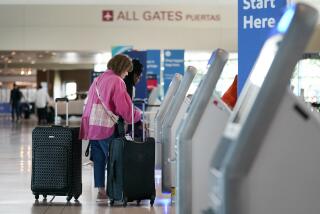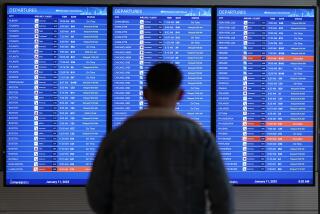NEWS ANALYSIS : Profits for the Nation’s Airlines Are Soaring Again : Transportation: The industry has gotten back on track in large part because it has been able to push fares higher.
The nation’s airlines are enjoying robust profits again after five years of heavy losses, and industry executives and analysts predict that the hefty earnings should continue for at least six more months, barring an unexpected dive in the economy.
Thanks to a steadily growing economy and stable passenger traffic, the airlines have been nudging fares higher in many regions of the country--or at least avoiding the disastrous price cutting of recent years that was a boon to consumers but left the airlines crippled.
There is one exception: California. Fare wars continue to rage in the West as Southwest Airlines, United Airlines’ Shuttle, America West and others fight for market share. Advance-purchase fares recently dropped as low as $19 between Los Angeles and San Francisco.
But the higher prices overall are helping the airlines post dramatically improved results. Business fares are up 12% on average in 1995, and leisure fares have risen 5% to 6%.
The latest example came Thursday, when third-ranked Delta Air Lines said profit for its fiscal first quarter ended Sept. 30 more than doubled from a year earlier to $201 million, excluding a one-time gain from an accounting change last year.
Delta’s news followed bullish announcements from other carriers this month:
* UAL Corp., United’s parent company, said its third-quarter profit nearly tripled from a year earlier to $243 million, aided by a $5-million profit from the shuttle.
* Continental Airlines, having abandoned its failed low-fare Lite operation in the East earlier this year, said its third-quarter net income of $111 million was the highest quarterly profit in its 61-year history.
* Even loss-plagued USAir posted a profit for the quarter ended Sept. 30, its first earnings for that period in seven years.
The airlines collectively are expected to earn at least $1.5 billion in 1995, after having suffered losses totaling $13 billion from 1990 through 1994. Executives said economic growth in the next two quarters, which has been forecast, also should keep the airlines solidly in the black as they enter 1996.
The American Stock Exchange’s index of 10 airline stocks has soared 77% this year, compared to a gain of 26% in the Standard & Poor’s 500 composite index. Investors’ warm reception for airline shares also enabled two smaller carriers, Midwest Express Airlines and World Airways, to complete initial public stock offerings this year.
“The industry environment remains very healthy,” said Gerard J. Arpey, chief financial officer of American Airlines’ parent, AMR Corp., whose third-quarter profit rose 13% from a year earlier.
Several factors set the airlines on a profitable course. The growing economy boosted passenger traffic as the airlines were cutting costs. The carriers were also stabilizing or scaling back route systems and the number of planes they operate.
In other words, the airlines better matched the industry’s supply--that is, its planes and the times at which they fly--with the demands of passengers seeking to fly those routes.
“That led to fewer seats chasing those passengers,” and so reduced the need for widespread fare cuts to attract traffic, said Michael Lowry, president of Aviation Forecasting & Economics, a consulting firm in Lake Oswego, Ore.
“So management can take credit for at least half of [the industry’s rebound], and the other half would be credited to our economy,” he said.
*
But in an industry notorious for booms and busts, there are plenty of reasons why the airlines cannot sit back and enjoy their current ride, analysts said.
Many of the biggest airlines remain laden with billions of dollars of debt, and they face prickly contract negotiations with their unions at a time when the carriers remain under pressure to continue slashing labor and other costs to keep profits growing.
Moreover, analysts fret that when the next economic slump does arrive, the airlines will revert to price-cutting to fill empty seats, once again eroding their profits. “Fare wars might resume in earnest” once the economy nose-dives, Lowry said.
But Pieter Bouw, president of KLM Royal Dutch Airlines, said he believes “most of the airlines learned their lesson” about fare wars in the early 1990s.
“They learned it’s a dead-end street that will only bring them to the edge of Chapter 11” bankruptcy proceedings, he said during a visit to the United States last week.
Bouw, whose airline has a 25% stake in Minneapolis-based Northwest Airlines, is among the executives who also expect airline mergers in the months ahead. UAL already has confirmed that it is mulling a possible purchase of USAir, which is also reportedly being looked at by AMR.
A spate of airline marriages in the late-1980s generally backfired, largely because the industry then was taking delivery of many new jets. That increased the number of available seats just as the economy was headed into a recession and passenger traffic was falling off.
But Thomas Longman, an analyst with Lehman Bros. in New York, said mergers make sense today because the economy is stronger, airlines are not aggressively adding to their fleets and the carriers need to find ways to keep profits growing.
At their current size, he said, the airlines “are not going to double or triple their earnings against next year” because passenger traffic is growing only slightly “and there’s a limit to how far costs can be cut.”
Wouldn’t the airlines’ hefty debt loads preclude such deals? Not if the airlines can use their bulging profits to rapidly reduce their debts--as AMR, UAL and others are now doing--before the economy goes sour again, Lowry said.
While they are flying high, the carriers “have a good opportunity to make strong inroads” toward paring their debts, he said. But, he added, “they must restructure as quickly as they can.”
(BEGIN TEXT OF INFOBOX / INFOGRAPHIC)
Flying High
U.S. airlines’ profits are sharply higher this year thanks to a healthier economy, rising passenger traffic and carriers’ cost-cutting efforts.
*--*
Quarterly Percentage earnings change from Airline (millions) a year ago UAL United $243 +196% Northwest 231 +36 AMR American 231 +13 Delta 201 +179* Continental 111 +258 Southwest 68 +16 USAir 43 NA**
*--*
* Excluding accounting-change benefit a year earlier.
** NA: Not applicable because of year-earlier loss.
Note: Earnings are for quarter ended Sept. 30
Passenger Traffic Industrywide
In millions:
1994: 519
Sources: Air Transport Assn.; Value Line Investment Survey, company reports
More to Read
Inside the business of entertainment
The Wide Shot brings you news, analysis and insights on everything from streaming wars to production — and what it all means for the future.
You may occasionally receive promotional content from the Los Angeles Times.











